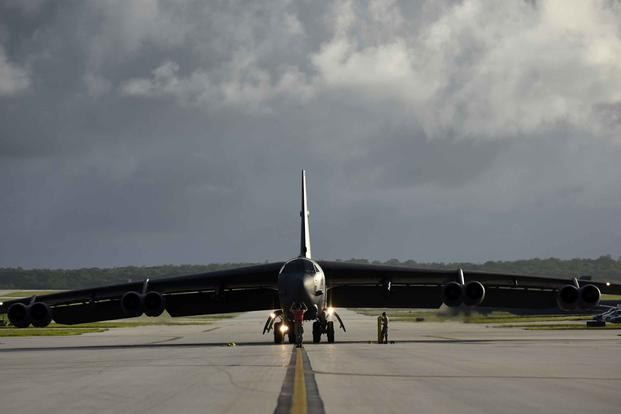The U.S. Air Force has ended its 16-year mission to keep strategic bombers in Guam to reassure allies and act as a deterrent against adversaries in the Pacific.
Air Force Global Strike Command announced Friday that it is transitioning to a new model, ending the continuous bomber presence (CBP) mission in favor of forward-deploying bombers to the Indo-Pacific.
"U.S. strategic bombers will continue to operate in the Indo-Pacific, to include Guam, at the timing and tempo of our choosing," the command said in a statement. The news was first reported by The Drive.
Related: Air Force Planning Shorter, More Frequent Strategic Bomber Rotations
"We will maximize all opportunities to train alongside our allies and partners to build interoperability and bolster our collective ability to support a free and open Indo-Pacific. We continually reassess our overseas posture and adjust to meet the requirements of the Joint Force and combatant commanders, as well as our treaty commitments," AFGSC officials said.
The announcement comes days after a handful of B-52 Stratofortress bombers joined nine other aircraft at Andersen Air Force Base in Guam for a formation known as an "elephant walk."
The long-range bombers joined six KC-135 Stratotanker aerial refuelers; an MH-60S Knighthawk helicopter; an Air Force RQ-4 Global Hawk; and a Navy MQ-4C Triton for the display, meant to showcase force "readiness and ability to generate combat airpower at a moment's notice," Pacific Air Forces officials said.
Aircraft spotters noted the B-52s -- with call signs SEEYA01-05 -- returned to the U.S. just days after the demonstration.
The B-1B Lancer, B-52 and B-2 Spirit have rotated back and forth to Andersen for more than a decade. The B-1 and B-52 have each held the watch for months-long rotations, while the stealthy B-2 customarily joined its bomber cousins for short-term deployments.
In 2018, the B-52 replaced the B-1B in the Pacific. The move marked a significant shift to bring back the B-52H -- which provided a continuous bomber presence in the region from 2006 to 2016 -- to put a nuclear-capable bomber in theater at a time when relations between the U.S. and North Korea were largely unpredictable. Between 2016 and 2018, the B-1 held the deterrence mission, marking the first time the aircraft had been housed at Andersen since 2006.
For the last year, AFGSC officials have planned more and shorter strategic bomber rotations in order to test the Air Force's agility when deploying its heavy aircraft forces around the world.
The concept, known as "dynamic force employment," mimics how the service often sends its bomber forces to Europe for weeks-long summer exercises. For example, the European theater has had a bomber rotation at least once a year as part of Operation Atlantic Resolve since Russia's annexation of Crimea in 2014.
"I am focused a lot on a different operational mentality in the command, to think about great power competition," Gen. Timothy Ray, head of AFGSC, told reporters during a Defense Writers Group breakfast in Washington, D.C., last year. He said he is against stationing bomber forces permanently in any one region in order to pivot away from predictable movements, especially as the Defense Department continues to posture itself to counter China and Russia.
"Why would I do that?" Ray said. "Why wouldn't I [instead] bring significant combat capability to the theater in a time and place of our choosing and … bring regional stability [to allies and partners?]"
Last fall, Ray told Military.com that the model will help keep airmen and maintenance crews ready and relevant for a future conflict.
"[The deployments are] short, they're crisp; they're not long and enduring. [And] there's something that's really important for everybody to understand -- there are no ally bombers. This is one thing that we do better than anybody else," he said in September.
Earlier this month, Air Force Chief of Staff Gen. David Goldfein hinted that changes for the CBP mission were on the horizon.
"We are continuing to adjust the continuous bomber presence to also incorporate dynamic force employment," he said during a Mitchell Institute "Aerospace Nation" video conference April 1.
"We're on a path that the secretary of defense has laid out, which is to be strategically predictable, but operationally unpredictable."
-- Oriana Pawlyk can be reached at oriana.pawlyk@military.com. Follow her on Twitter at @Oriana0214.
Read more: Military Travel Ban Extended Until June 30; Some Restrictions Eased















